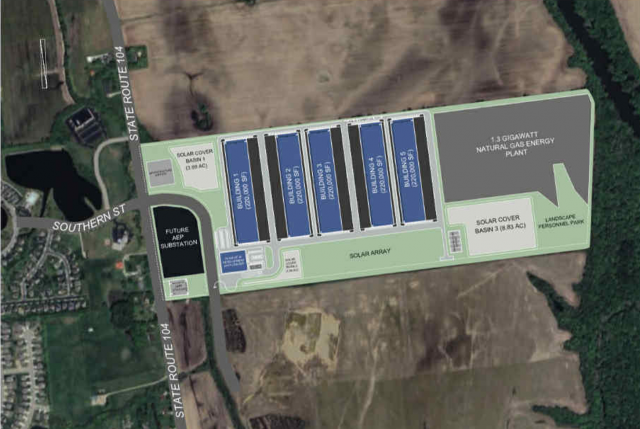
COMMERCIAL POINT, Ohio — A new 152-acre data center campus, dubbed the Commercial Point Data Campus, is stirring debate in this quiet Ohio community. Marketed by JLL, the $1.75 million square foot facility is set to include a 1.3-gigawatt natural gas plant and a solar array, located near Southern Point. The project, which is not affiliated with the nearby AWS site, has sparked strong opposition from a local group that argues it threatens their residential neighborhood.
The Commercial Point Data Campus is designed as a high-performance hub for AI, cloud computing, and data-driven industries. Spanning three phases, the campus will deliver an initial 75,000 square feet of data on inital development, with plans to expand to 220,000 square feet in the next few years and an additional 450 megawatts of grid-connected power by 2029. The site will be powered by redundant hydrogen supplementation reactors and a natural gas plant, aiming to provide a reliable, scalable energy solution. A site plan outlines the layout, including building clusters, a solar array, and landscaped areas, situated off State Route 104.
However, a local group is already pushing back. According to Cory Wasmus, who represents Teays Valley Against Overgrowth, who recently spoke out against a similar solar project in Amanda within the Teays Valley School District: ‘I’ve opposed solar sprawl and speculative data centers being dropped into our neighborhoods. I support responsible growth, but I will firmly stand against any overgrowth that threatens Teays Valley’s schools, infrastructure, and way of life.” The opposition highlights concerns over the facility’s energy demands and environmental impact, with plans to address the Commercial Point village council to halt or modify the proposal.

Data centers are notoriously energy-intensive, consuming vast amounts of electricity to power servers and cooling systems. In the U.S., they account for approximately 2% of total electricity use, a figure projected to surge by 160-165% by 2030 due to the rise of AI and digital services, according to Goldman Sachs. The Commercial Point campus’s 1.3-gigawatt natural gas plant aims to meet this demand, supplemented by solar energy and hydrogen reactors, but critics question the sustainability of relying on fossil fuels in a residential area.
The project’s marketing brochure, by JLL, emphasizes its innovative design and proximity to Central Ohio’s growing data center hub, including major players like Amazon and Microsoft. Yet, residents remain skeptical, citing potential disruptions to their quality of life, including increased traffic, noise, and environmental concerns. As the debate intensifies, the balance between technological advancement and community preservation hangs in the balance in Commercial Point.
Teays Valley Against Overgrowth contributed some information to this Article










